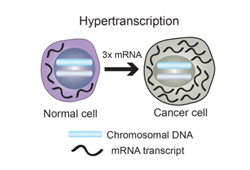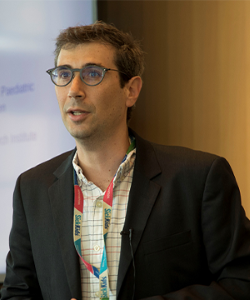Researchers develop novel algorithm to unlock role of cellular phenomenon in aggressive cancers
Summary:
SickKids researchers develop an innovative computational method called RNAmp to measure hypertranscription in human tumours, with novel implications for cancer care.

Scientists at The Hospital for Sick Children (SickKids) have developed a novel computational tool to directly measure hypertranscription in tumour cells, a feature present in almost all cases of human cancer, with novel implications for treatment strategies.
In the study published in Science Advances, researchers developed a new algorithm called RNAmp to examine over 7,000 tumours spanning 31 cancer types and demonstrated hypertranscription is present across most cancers. Hypertranscription is a unique phenomenon that occurs when transcription, the process by which new RNA molecules are created, is increased leading to elevated RNA output across the entire genome.

“Until now, scientists have lacked the tools to meaningfully measure hypertranscription in tumours,” says Dr. Adam Shlien, a Senior Scientist in the Genetics & Genome Biology program who led this research. “With RNAmp, we can now see these massive, global changes in RNA output and better understand its role as a marker of aggressive disease.”
Across all cancers, RNA output was associated with a 42 per cent increased risk of mortality within five years of cancer diagnosis, and this was much higher for aggressive cancers. Using this data, the researchers were able to identify novel subtypes of aggressive cancers which were previously unexplained.
The team also found that tumours with higher levels of hypertranscription expressed more mutations, opening the door to alternative treatment pathways for patients, including immunotherapy which is significantly more effective for hypermutant tumours.
“Beyond the traditional DNA-based methods, this new RNA-focused approach provides a more efficient way to identify patients who may be otherwise be ineligible for immunotherapy and get them the treatment they need sooner,” says Dr. Uri Tabori, Head of Neuro-Oncology, Senior Scientist in the Genetics & Genome Biology program and co-author of the study. Tabori also leads The International Replication Repair Deficiency Consortium, which has treated 100 patients globally with immune checkpoint therapy.
What’s driving hypertranscription?
The researchers identified 202 factors that drive hypertranscription. While some of these drivers actively increase transcription, many tumours were lacking factors that suppress transcription and keep it within normal levels. Without these suppressors, tumour RNA output levels became elevated.
“Our findings suggest a lack of transcriptional suppressors may be essential to the development of hypertranscription,” says Dr. Matthew Zatzman, first author on the paper who completed his PhD in the Shlien Lab in 2021. “As we collect more data on the drivers of hypertranscription in different tumours, the hope is to identify novel treatment strategies for specific cancer subtypes.”
Their analysis also revealed multiple new pathways to hypertranscription. Many of these pathways are specific to individual cancer types such as ETS fusions, a genetic mutation found in prostate cancer and Ewing sarcoma.
While the study highlights the potential of hypertranscription to uncover previously unknown tumour subtypes, Shlien and his research team are continuing to explore the predictive capacity of this cellular phenomenon.
“We now have a broader understanding of hypertranscription across cancer subtypes, but when you dive further into different tumour regions, certain cell clusters appear more dominant,” says Shlien, who holds a Canada Research Chair in Childhood Cancer Genomics. “By measuring hypertranscription at the time of diagnosis, we may be able to identify potential problem clusters earlier and predict recurrence before it happens.”
This research was funded by the SickKids Foundation, the Ontario Ministry of Research and Innovation, the V Foundation, Canadian Institutes of Health Research (CIHR), National Institutes of Health (NIH) and the Robert J. Arceci Innovation Award from the St. Baldrick’s Foundation.

